To subscribe, unsubscribe or change your email address, visit:
http://www.imaging-resource.com/IRNEWS/index-subs.html
Support the Newsletter!
- Find the best price for anything at http://ir.pricegrabber.com
- Shop Amazon, Adorama at http://www.imaging-resource.com/buynow.htm
=====================================================
THE IMAGING RESOURCE DIGITAL PHOTOGRAPHY NEWSLETTER
=====================================================
Volume 15, Number 9 - 3 May 2013
----------------------------------------------------------------------
Copyright 2013, The Imaging Resource. All rights reserved.
----------------------------------------------------------------------
Welcome to the 357th edition of The Imaging Resource Newsletter. In this issue, we take a brief look at the iconic images and life of U.S. Farm Service Administration photographer Jack Delano. We also share an excerpt from our latest camera review, examining many reasons why you might consider the full-frame Canon EOS 6D a better investment than its big brother, the 5D Mark III. And don't forget to check out our Quick Hits, We've Got Mail and New on the Site sections for a ton of camera- and photography-oriented material for your reading pleasure. We hope you enjoy!
TOPICS
---------
Feature: The Rhythm of the Rails - Jack Delano's iconic 1940s images of trains and railyards
Review: Canon EOS 6D Shooter's Report (Excerpt)
Quick Hits
We've Got Mail
New on the Site
Next Issue
Signoff
SPONSORS
--------------
This issue is sponsored in part by the following companies. Please show your appreciation by visiting the links below. And now a word from our sponsors:
* Sigma *
At the new Sigma, photography is our one and only focus.
Our new line of lenses are a tour de force, ranging from the
35mm F1.5 DG HSM 'Art' to the 17-70mm F2.8-4 DC Macro OS HSM
'Contemporary' to the 120-300mm F2.8 DG OS HSM 'Sport'.
Our cameras, featuring the Foveon X3 sensor, include the SD1 and the
DP Merrill, produce the highest quality digital images.
Learn more about Sigma offerings at http://www.imaging-resource.com/cgi-bin/nl/pl.cgi?sg13
---------------------------------------------------------------------------------------------------------------
Are you in the digital photo business? This newsletter is read by more than 47,000 direct subscribers (plus additional pass-along readers), all with a passion for digital photography. For information on how you can reach them, contact us at editor@imaging-resource.com.
---------------------------------------------------------------------------------------------------------------
FEATURE: The Rhythm of the Rails - Jack Delano's iconic 1940s images of trains and railyards
-------------
(Note: To see more images by Jack Delano, click through and view the story on our site at http://www.imaging-resource.com/news/2013/05/03/the-rhythm-of-the-rails-jack-delanos-iconic-1940s-images-of-trains)
By Steve Meltzer
Jack Delano's gorgeous color images from the 1940s remind us of the day when railroads dominated the American landscape -- and the American consciousness. The gigantic locomotives, the play of light on steel rails and the huge roundhouses were all elements that spurred the imagination and presented a subject of infinite possibilities for a photographer. The railroads had bound the country together and opened the West. Chicago was the hub, especially the Chicago and Northwestern Railway Company's Proviso yard.
Working for the U.S. Farm Security Administration, he traveled across America photographing the effects of the Depression on American life. At the time, the railroads meant freedom and they seduced thousands of unemployed men -- and some women -- to ride the rails. They hitched rides on freight trains and hid in empty cars or slept on top of them, always on the alert for the railroad cops. In the depths of the Depression, their primary goal was to get "somewhere else" and find a job.
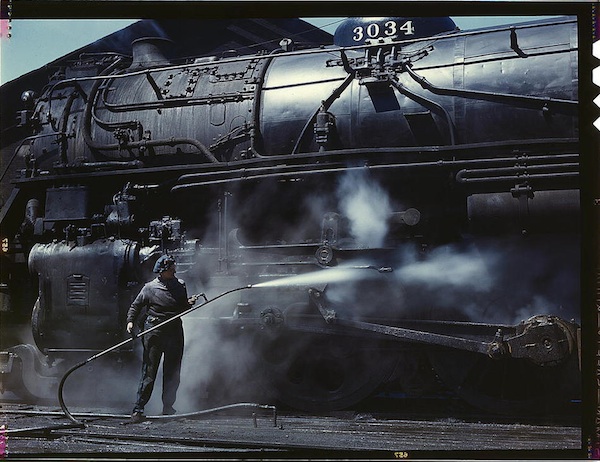
Mrs. Viola Sievers, one of the wipers at the roundhouse giving a giant "H" class locomotive a bath of live steam. Clinton, Iowa, April 1943. Reproduction from color slide.
Photo by Jack Delano. Prints and Photographs Division, Library of Congress
Delano was originally one of those job seekers himself when he proposed a photographic project to document the mining operations and working conditions of the Schuylkill County, Pennsylvania-area, coal mines. He sent samples of his photographs and applied for a job at the FSA's Photography program, which was headed by the charismatic Roy Stryker and was part of President Franklin Delano Roosevelt's 1933 New Deal -- a program aimed at creating jobs for some of America's millions of unemployed.
At the recommendation of the photographer Marion Post Wolcott, Stryker hired the young Delano on the condition that he had his own car and a driver's license. At a salary of $2,300 a year, Delano -- along with Wolcott, Russell Lee, Walker Evans, Gordon Parks, Dorothea Lange and others -- helped produce what is probably the greatest photographic record of American life ever made.
Surprisingly a large number of these images were shot in color with the newly available Kodachrome transparency film. Delano was one of the FSA photographers who shot a good deal of his work in color, both as Kodachrome 35mm slides and medium format transparencies. In 2006, the Library of Congress produced an exhibition, Bound For Glory, which for the first time featured a collection of these color photographs taken by the FSA photographers.
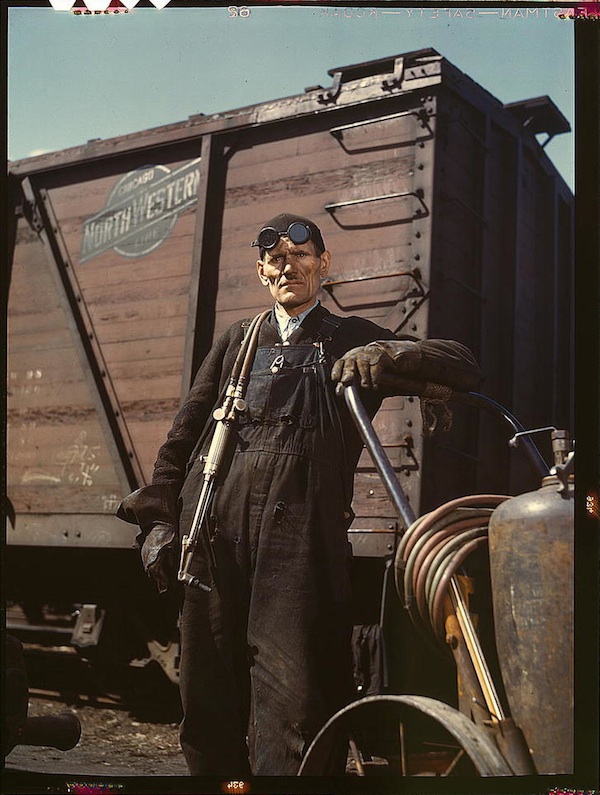
Mike Evans, a welder, at the rip tracks at Proviso yard of the Chicago and Northwest Railway Company. Chicago, Illinois, April 1943. Reproduction from color slide.
Photo by Jack Delano. Prints and Photographs Division, Library of Congress
The benefits of classical training
Born Jacob Ovcharov in 1914 in the small Russian village of Voroshilovka, Delano came to America in 1923 with his parents and younger brother. By the age of 9 his creative talents were already evident, and he attended the Settlement Music School in Philadelphia where he studied graphic arts, photography and the viola. After that he continued his studies of illustration and music at the Pennsylvania Academy of the Fine Arts until 1932.
In these Chicago Northwestern Railroad photographs, I think you can feel Delano's musical training. Like his contemporary -- the similarly classically trained Ansel Adams -- there is the same sense of power and grandeur. They share the romanticism of the New World, where Nature and Technology have replaced the old gods. In Delano's photographs the trains and the railyards dwarf people, in much the same way as the landscape does in Adams' photographs.
More than just a photographer
In 1941, Stryker sent Delano to photograph rural poverty in Puerto Rico. He fell in love with the island and in 1946 he and his wife Irene settled there permanently. Delano began to write music, and for the next 50 years produced full orchestral, chamber and instrumental works, choral pieces and more.
In Puerto Rico, Delano began to make movies of island life and in 1953 directed and wrote the score for a film called Los Peloteros about poor rural kids and their love for baseball. The film became a classic in Puerto Rican cinema.
Like so many photographers of his time, Delano was a multi-faceted talent. And although he died in 1997, he left us the legacy of his superb photographs and his music compositions.
To hear one of Delano's musical compositions and view a clip from his movie Los Peloteros, view the story at our site: http://www.imaging-resource.com/news/2013/05/03/the-rhythm-of-the-rails-jack-delanos-iconic-1940s-images-of-trains
---------------------------------------------------------------------------------------------------------------
REVIEW: Canon EOS 6D Shooter's Report (Excerpt)
-----------
(You can check out our in-depth Canon EOS 6D review, complete with gallery photos, lab test results and our final conclusion, here: http://www.imaging-resource.com/PRODS/canon-6d/canon-6dA.HTM)
By Dan Havlik
I was pretty excited when I first got a chance to play with a prototype Canon EOS 6D at the Photokina imaging show in Germany last year. Along with the Nikon D600, which shares more than a few traits with the 6D (don't tell that to Canon or Nikon!), Canon's latest prosumer DSLR seems to solve a problem that has confounded camera manufacturers for years. How do you create an affordable full-frame sensor DSLR? Both the 20.2-megapixel Canon 6D and 24.3-megapixel Nikon D600 seem to answer that question by offering pretty sophisticated full-framers at virtually the same price tag.
You might say, "Well, $2,000 isn't exactly affordable, now is it?" And you'd have a point. But considering the costs of manufacturing a full-frame chip versus an APS-C size sensor, or even the pinkie-nail sized chips in compact cameras, Canon and Nikon have priced the 6D and D600 surprisingly competitively for the category. The $2,000 range of the 6D and D600 may just hit a sweet spot for prosumers and advanced amateurs.
At least that's what the companies hope, and after shooting with both of these cameras, I can say you do get a lot of bang for your buck with these "affordable" full-framers. We've already reviewed the Nikon D600, so let's take a look at Canon's offering, the EOS 6D, which adds two features its Nikon rival doesn't have: built-in Wi-Fi and GPS.
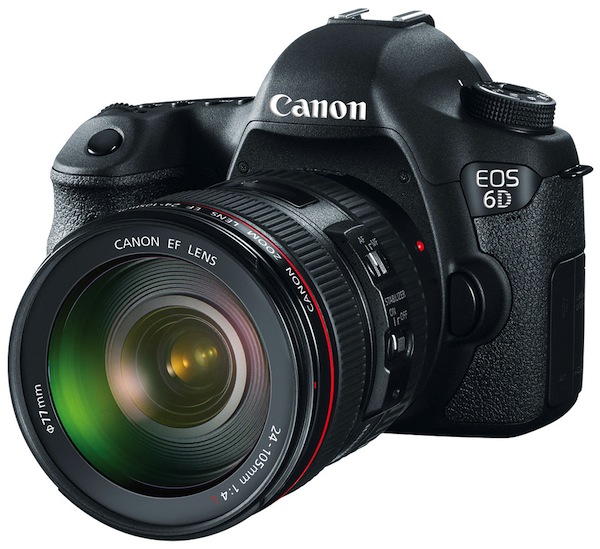
In the hand. My initial impression of the Canon 6D -- which still holds true now -- is that it looks and feels like a mini 5D Mark III. And, for me, that's a good thing. The step-up 5D III model is a solidly built HD-DSLR, combining the serious and durable aesthetics of Canon's professional 1D line with the portability and accessibility of 5D models before it. In terms of looks and camera build, the Canon 6D sits just below the 5D III and the APS-C-sensor-driven 7D, which both have full magnesium alloy bodies. The 6D features an aluminum alloy and polycarbonate chassis, while the shell is part-magnesium alloy. The top panel is polycarbonate, likely a necessity because of the integrated GPS and Wi-Fi radios.
With dimensions of 5.7 x 4.4 x 2.8-inches (145 x 111 x 71 mm) and a measured weight of 27.4 ounces (778 g) with SD card and its proprietary, rechargeable battery loaded, the 6D is certainly on the small side for a full-frame DSLR but it does not feel slight. (Incidentally, the 6D's size puts it closely in line with the Nikon D600, though the Nikon camera's body is a bit deeper and about 3 ounces heavier.)
The Canon 6D is about 20% lighter than the 5D Mark III and if you've held that model before, the 6D won't feel quite as robust with a slightly less solid build overall. But if you're moving up from an entry-level DSLR, such as a Rebel, the 6D will feel impressive and almost luxurious. The body has extensive textured rubber on the exterior, both on the handgrip and the opposing side. There's also faux-leather rubber on the back of the camera, including the thumbrest. Overall, the 6D feels refreshingly lightweight, comfy and well protected.
To help keep the weight, size and cost down, Canon decided to forgo the pop-up flash with the 6D, a feature that's standard on most prosumers DSLRs. Some novice photographers stepping up in class to the 6D might miss the built-in flash but there is, of course, a hot shoe on top if you want to add an external flash. The 6D is not quite as fully weatherized as the 5D Mark III but it's on par with the 7D, and can withstand a few raindrops and splashes.
It should be said that while both the Canon 6D and Nikon D600 are noticeably smaller and lighter than other current full-frame DSLRs on the market, don't expect to be able to fit either of these cameras in your pocket (possibly in a large coat pocket if you have a short prime lens attached, but even that would be a tight fit).
When I attached a few zoom lenses, including a Canon 16-35mm f/2.8 and a 24-70mm f/2.8, the 6D didn't feel that different than a 5D Mark III. Sure, there are less expensive, lighter zoom lenses out there that would make the 6D a more portable package, but the reason one buys a full-frame camera is to get the most out of your glass. So, therein lies one of the paradoxes of the 6D: the full-frame camera body might be relatively lightweight and reasonably priced but the top-notch lenses you'll want to use with it definitely won't be.
Overall, the Canon 6D is an extremely comfortable and surprisingly sturdy DSLR to use. While pros might scoff at the 6D's build, they're not who this camera is designed for. Anyone moving up in class from compact cameras and consumer or APS-C-based DSLRs will find the design of the fully-framed 6D to be just right.
Controls. In terms of controls, as you might suspect, the Canon EOS 6D mimics the 5D Mark III but with some distinct differences. For one, the layout on back of the 6D is more Spartan than the 5D Mark III, with the buttons moved from the left panel next to the LCD monitor over toward the center-right side of the 6D's rear. This is not a big deal, especially since most people interested in this camera will not have shot with a 5D Mark III previously. Some of the buttons, including those for playback, magnify, and trash are small and slightly scrunched though, and I don't like the smaller Quick Control Dial. Along with being diminutive, the wheel is stiff and not very responsive. The multi-direction pad in the center of the wheel is also tough to press when you're in a hurry.
Another victim of cost (and size) cutting with the budget-friendly 6D is the useful, multi-direction joystick from the 5D Mark III. That's a bummer, especially for beginners moving up to the 6D, but you've got to get rid of something. Canon Rebel users will likely already be familiar with the rear Quick Menu button (identified by the Q icon), and it has become my preferred method for making fast changes to important functions such as ISO, exposure compensation and white balance. While the 6D has an ISO button on top, there's no physical white balance button, which is disappointing. One thing that I did like was that Canon included the Live View/Movie Record switch and button cluster on the back of the 6D. It's a really simple and fast set-up, which appears on the 5D Mark III but not on the lower-tier Rebels.
Like the 5D Mark III, the Canon 6D's knurled mode dial on top of the camera has a central locking button and most of the familiar settings. But while the 5D Mark III's dial looked strangely half filled, the 6D piles on the options including a Scene (SCN) mode setting, which lets you pick from a variety of pre-sets including familiar ones such as Sports, Close-up, Landscape and Portrait, as well as less common ones including Night Portrait, Handheld Night Scene and HDR Backlight Control.
The Canon EOS 6D's mode dial also offers a Creative Auto (CA) mode option, which I actually found to be a little more confusing than it should be. When CA mode is selected you can choose from one of nine "Ambiance-based shots," including Standard, Vivid, Soft, Warm, Intense, Cool, Brighter, Darker or Monochrome. Scroll down though and you can also select whether to blur or sharpen the background. The CA mode also lets you choose the Drive mode, including Single, Continuous (approximately 4.5 shots per second), Silent single shooting, Silent continuous shooting, Self-timer (10 sec./Remote control), or Self-timer (2 seconds/Remote control). That's a lot of combinations to choose from and, hopefully, more adventurous novices will take advantage of them. I'm not sure how much I would on a regular basis, though they were fun to experiment with.
In terms of controls, the most important of them all (at least in my book), is placed front and center in slight indent on top of the Canon 6D's handgrip: the responsive and well-positioned shutter button. The 6D loves to take pictures, which is a trait any photographer should appreciate.
LCD Screen. The LCD monitor on the 6D is quite nice, as is true on all of Canon's latest DSLRs. It's a 3-inch, Clear View LCD panel with 1.04-million dots of resolution, and images looked sharp in playback and the video feed was crisp with a good refresh rate. Again, no real surprises here since most of Canon's DSLRs have sweet LCDs. The 6D's screen is not a flip-out, articulating display, which is harder to weatherproof. It's also a slight downgrade in size from the 5D Mark III, which has a 3.2-inch LCD.
The Canon 6D's screen has a good 170-degree viewing angle if you want to let others see what you've shot, while Live View mode offers 100% coverage. Speaking of Live View, the 6D has a decent digital, single-axis level gauge function that you can use during live view. It'll help you keep your horizons level -- I'm admittedly poor at eye-balling without the gauge -- but it's a step down from the dual-axis level on the pricier 5D Mark III, which also shows front and back pitch.
The 6D display's Clear View designation is a notch below the Clear View II screen that's on the 5D Mark III, and the main difference is the higher-end screen fares better in outdoor lighting, with higher contrast and less glare. Truth be told, I haven't used any camera LCD that doesn't wash out somewhat in bright light and the 6D is no exception. But, of course, that's what the 6D's optical viewfinder is for. Like the LCD screen, it's a good one, offering about 98% coverage in our testing, which is actually a tick higher than Canon's 97% advertised spec. The 6D's optical viewfinder offers 0.71x magnification, 21mm eyepoint, and a -3 to +1 diopter.

The Canon 6D does a nice job capturing action, but just don't expect
the same results you'd get with, say, a Canon 1DX.
Autofocus. Along with being smaller and less expensive than the 5D Mark III, the Canon 6D has a different, somewhat less sophisticated autofocus system. Where the 5D Mark III boasts a pro-level 61-point High Density Reticular Autofocus System (with up to 41 cross-type points and five dual cross-type points), the 6D's employs a rather basic 11-point system with one cross-type point in the center. However, the 6D's center AF point has a working range rated at -3 to 18 EV, while the 5D Mark III's AF system is rated at - 2 to 18 EV and Nikon D600's -1 to 19 EV. This means the Canon 6D should be able to focus in lower light when using the center AF point.
While on paper that might sound significant, it's less noticeable in real-world use. I think most prosumer photographers will probably find the 6D's 11-point AF to be more than enough to handle most shooting situations, though.
However, there's some bad news. In certain circumstances, such as when shooting in very low light and in extremely low contrast situations, the Canon 6D struggled, a bit, to find focus. Such as when some sample shots taken in a bar and around the pool table (see above and below) captured by my co-tester, pro-photographer Jordan Matter. I say "a bit" because it still achieved focus lock but was just not as quick in these situations as both the 5D Mark III and Nikon D600 were. (It's worth noting that the Nikon D600 has a 39-point AF system, with 9 cross type points.) Consequently, if you're an aspiring wedding or sports photographer who might have to deal with tricky lighting on a regular basis -- such as during a wedding reception or in a poorly lit stadium -- the Canon 6D might not be for you.
Otherwise though, I was actually quite impressed with my results from the Canon 6D's 11-point AF system. I expected it to feel slower and less responsive than Canon's other higher-end EOS DSLRs, but it was surprisingly spritely. In good, outdoor lighting, you'll have no complaints about the 6D's AF. I also deliberately shot with the 6D in low-contrast settings and swung the camera quickly from subject to subject to see how fast it would take to refocus, and the 6D hung in like a champ. Those shots, which were captured using a rather high-end 24-70mm f/2.8 Canon lens, had very good sharpness when reviewed later on my computer.
Performance. The Canon 6D is a decent performer for a prosumer, full-frame DSLR. (Ok, at the time of this writing there are only two cameras that qualify in this category, but the 6D was still reasonably fast all around.)
Start up and shut down times for the 6D were fast enough -- 0.5 and 0.3 second, respectively -- that they were difficult to measure. The 6D also did well in clearing its buffer, taking just two seconds to get ready to take a photo after we fired off 20 consecutive large/fine JPEGs. It took about 9 seconds to clear the buffer after shooting 17 RAW images and 7 seconds after 7 RAW+L/F JPEG photos. Of course, it helps to have a fast card (which we highly recommend), and we tested the 6D with the blazing fast SanDisk Extreme Pro 95MB/s SDHC card, which is UHS-I compliant.
Our lab timed the Canon 6D's autofocus shutter lag, using single center-point AF, at 0.290 second, which is actually slower than average for a prosumer DSLR. It's hardly noticeable in real world-usage, however, and I found the 6D to be generally quick to lock in on a subject and snap a photo when I pressed the shutter.
When using the full 11-point Auto Section AF mode, the 6D was faster, according to our lab tests, averaging 0.206 second (though it varied widely, between 0.1 and 0.3 in our tests.)
As with most cameras, prefocusing by half pressing the shutter is the way to go with the Canon 6D. This produced a lag time of just 0.059 second, which is quite fast for a DSLR. On the other hand, AF lag in Live View mode was longer, which is no surprise. We clocked it at about 1.7 seconds using the phase-detection based AF "Quick Mode." Strangely, using Live Mode, (contrast-detection AF), it was a lot faster at 0.7 second.
Bottom line: If you're moving up in class from an entry-level DSLR or even a compact or point-and-shoot camera, the Canon 6D is going to feel hella fast.
In terms of shooting speed, the 6D is capable of firing off up to 4.5 frames per second in burst mode (the lab measured 4.4), a fair tick slower than the 5D III's 6 frames per second, and about a frame per second slower than the Nikon D600. But it's just enough for shooting basic action, such as capturing modeling poses, candid photographs and low intensity sports. For faster action such as basketball, soccer or anything at the Olympic level, however, you'll want to step up to Canon or Nikon's pro DSLRs. The 6D's generous camera buffer also lets you keep shooting JPEGs until the SD card fills. When shooting RAW, you get a decent 17-frame buffer until the camera needs to pause to catch up.
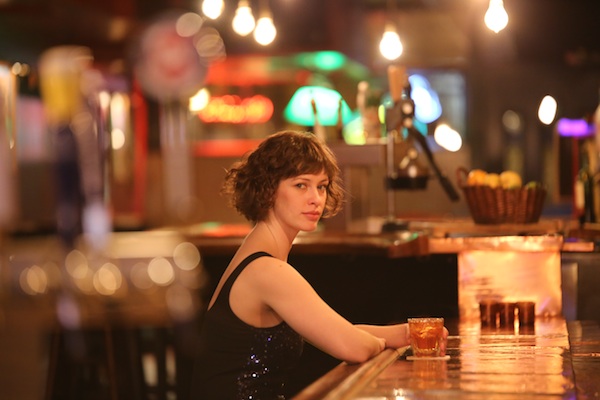
The Canon captures images with good dynamic range and lots of subtle detail thanks
to its impressive 20.2-megapixel, full-frame CMOS sensor. (Photo by Jordan Matter)
Image quality. The Canon EOS 6D's CMOS sensor is a smidge smaller than the 5D Mark III's - 35.8 x 23.9mm vs. 36 x 24mm -- so it's not technically full frame. That's not that big of a deal, however. It didn't seem to compromise image quality during our testing. I actually found that image quality from the 6D was about equal to the results I got from the 5D Mark III and that's saying something: the 5D Mark III was one of the best cameras I shot with last year.
While the Canon 6D's chip might be a fraction smaller, the individual pixel size is larger because the 6D has slightly less resolution. The 20.2-megapixel 6D's photosites are 6.5 microns a piece vs. 6.2 microns in the 5D III's 22.3-megapixel sensor. But how do these numbers translate into the real world? Quite well, it turns out.
As I noted before, I had a professional photographer friend, Jordan Matter, co-test the 6D with me to get another perspective on the camera. In short, we were both impressed with the 6D's skills as an available-light camera.
Jordan is the photographer behind the "Dancers Among Us" project, where he photographs professional dancers performing in everyday settings, typically without artificial light. Last year, "Dancers Among Us" was published in book form by Workman Publishing but Jordan continues to work on the series. He used his 5D Mark III for some of the shots, and was curious to see how the 6D stacked up against it.
With the Canon 6D paired with a Tamron SP 70-200mm, f/2.8 Di VC USD lens, he captured images of a dancer performing on a Manhattan street at night (above) and hanging out inside a dimly lit bar that were virtually noise-free up to ISO 3,200. Shots at ISO 6,400 were also quite nice: crisp and clear with only a bit of color noise in the shadows. Realistically, you can easily get away with pushing the 6D to ISO 12,800 if you need it, which gives you a lot of versatility. (Maximum ISO, in the 6D's expanded mode, is 102,400, while the minimum is ISO 50. In contrast, the D600's expanded range is ISO 50 to 25,600.)
Part of the credit should be given to the DIGIC 5+ image processor, which, on the 5D Mark III and elsewhere, has proven to be fairly good at tamping down noise when images are output from the camera's sensor. The Canon 6D uses 14-bit analog-to-digital conversion on its sensor to produce images that have great color and dynamic range while keeping noise in check. In daylight and with strobes, results were even better.
I also tested the Canon 6D while shooting publicity portraits of a children's book author/illustrator, which she could use on her book jackets or to promote herself in print or online. In this case, I paired the 6D with a Sigma 35mm F/1.4 DG HSM and shot in bright natural light outdoors and dim hallway lighting indoors. My results were quite good, with the 6D's full-frame chip and the Sigma lens' wide maximum aperture combining to produce images with tack-sharp center focus and attractive, background blur (aka bokeh) to make my subject really stand out.
While some DSLRs produce images with colors that are too oversaturated -- nearly all cameras oversaturate to some degree, simply because people tend to prefer brighter images -- the Canon 6D struck a good balance, by capturing the robust colors of my subject's scarf, without making it look garish or fake. More importantly for portraits, the author's Caucasian skintones were natural and healthy looking in my 6D shots. (Some consumer DSLRs can make skintones look excessively pink and almost doll-like.) I also shot some indoor hallway portraits, but found the 6D had some problems handling the incandescent lighting using the camera's Auto White Balance, a problem we also came across in our lab testing. In our testing, both the Auto and Incandescent White Balance produced strong reddish and orange casts, respectively. Adjusting White Balance using the Manual setting was much more accurate, but photographers who are moving up in class from a point-and-shoot, compac
t or consumer DSLR might not want to fiddle too much with that setting.
On the plus side, though, the Canon EOS 6D's excellent high-ISO performance helped me capture relatively clean images at up to ISO 6,400. In low-light test in our lab, the 6D performed very well, capturing bright shots at the lowest light level (1/16 foot-candle), down to the camera's base ISO of 100. Overall, despite a few issues with indoor lighting (which is not uncommon but disappointing nonetheless), the Canon 6D and its full-frame sensor produced excellent images in a range of lighting conditions, with superior detail and sharpness.
Video. The Canon 6D's HD video quality was stellar, about on par to my results with the 5D Mark III. Photographers who are moving up in class from another entry-level or compact camera should love the video results they get along with how easy the 6D is to use for quickly shooting video on the fly. As mentioned earlier, I really appreciate Canon's Live View/Movie Record switch and button cluster on the back of the 6D. Just flip the switch to the red movie camera icon, press the center button and you're off and recording a movie.
More experienced videographers, however, might miss a few features from the 5D III that have been left off the 6D. In particular, there's no headphone jack for checking audio levels as you shoot. (The 5D III has a built-in headphone jack.) Otherwise, the 6D can shoot full 1080p (1,920 x 1,080 pixel) HD with manual exposure control at a range of frame rates including 30, 25, or 24fps. You can also shoot 720p at 60 or 50fps. And you can shoot with the 6D in the high-quality ALL-I intraframe video format but you'll need a UHS-I compliant SD card to do that. (It's also worth noting that you have to disable the 6D's Wi-Fi when shooting video, so there's no way to monitor a live video feed on an iPad or iPhone while you shoot.)
The Canon 6D's big image sensor produced luscious video results for me, with eye-catching shallow depth of field and creamy color. I also saw very little of the rolling shutter effects that produce a wobbly, jell-o distortion when you aggressively pan while shooting video with some DSLRs. In some early reports on the Canon 6D, some reviewers complained that the camera had issues with producing moir� -- which are strange, multi-colored stripes that can occur in subjects with intersecting grid-like patterns -- in the video. During my testing, I deliberately shot with the 6D in situations where moir� might occur, such as the intricate brickwork on a building, intersecting power lines and the suspension cables on a bridge. I only saw moderate instances of moir�. One place it turned up severely was in the vents of window air conditioners but otherwise it didn't seem worse than with other HD-DSLRs.
Wi-Fi and GPS. The Canon 6D offers two unique features not available on its main rival, the Nikon D600, or on the step-up Canon 5D Mark III model: built-in Wi-Fi and GPS tagging.
In-camera wireless connectivity -- especially on a DSLR -- is something I see big potential for. Camera manufacturers have been trying to implement it for years but, so far, with no great success. Most of the set-ups I've tried have been glitchy, and the built-in Wi-Fi in many of Canon's own compact PowerShot cameras is not very user-friendly.
Luckily, Canon has updated the Wi-Fi interface on the 6D, making it a lot easier to use, especially when connecting the DLSR to an iPhone or Android smartphone or tablet with the help of Canon's free EOS Remote app. I was able to easily share images with my iPhone -- at a reduced size, of course -- get a live view from the camera on the phone, and control several functions on the camera via the app, including firing the shutter, focusing by touching the iPhone's screen, and adjusting ISO, aperture and shutter speed. (Note: You can also transfer photos from the 6D to your computer by pairing it over a wireless network, but you have to use the Canon EOS Utility software that comes packaged with the camera. The software also allows you to remote control the camera much like you can with a smart mobile device.)
You can watch a video demonstration of the EOS 6D's remote control capabilities here, with Canon's Chuck Westfall walking us through many of the 6D's exciting Wi-Fi capabilities, which you'll see seriously up the ante of what a camera can offer in terms of built-in wireless functionality and convenience.
Additionally, the 6D's built-in Wi-Fi is IEEE 802.11 b/g/n capable with a reported range of 100 feet, which I found to be fairly accurate. Many pro photographers -- as well as enthusiasts who take nature photographs or a lot of self-portraits -- should love this sizable range when paired with the 6D's considerable remote control features. You can also send your shots to a wireless printer from the 6D, but I don't know of many photographers who would do that often, that is, without editing the images first.
Despite the 6D's leg up on many of its competitors, there's still room for improvement with the camera's Wi-Fi capabilities. To post your images on social networking sites, you either need to send it to your smart device first and upload from there or transfer them through the Canon Image Gateway online photo service -- an additional step that some new point-and-shoots can now skip.
While some photographers will like having a GPS receiver built into their DSLR, it's not a must-have feature for me. I (usually) know where my images were captured and have no strong desire to put them on one of those digital maps in the included Map Utility software or Apple Aperture, and see where I've been. For those who do like this feature though, the 6D's GPS is solid, recording longitude, latitude, elevation and universal time code in your shots while also sporting a GPS logging function.
Read our final conclusion in our Canon 6D review online: http://www.imaging-resource.com/PRODS/canon-6d/canon-6dA.HTM
---------------------------------------------------------------------------------------------------------------
QUICK HITS: The most interesting, most-read articles on the IR site in the past two weeks
----------------
William Eggleston: The world's greatest photographer... or the worst?
By Steve Meltzer
Earlier this month, 73-year-old American photographer William Eggleston traveled to England to receive a Sony World Photography Award and to celebrate the opening of a permanent exhibition of his photographs at the Tate Modern in London. In reporting these two events, art critic Michael Glover of the Independent (UK) titled his article a little breathlessly, "Genius in colour: Why William Eggleston is the world's greatest photographer."
This may come as a shock to many photographers. I am even willing to bet that most people -- including many IR readers -- have never heard of William Eggleston before, much less have realized he was in the running for "world's greatest photographer."
Glover goes a little overboard with his praise when he writes:
"The way we do photography now would not have been the same without Eggleston. Martin Parr, Nan Goldin and Jeff Wall would not have been granted the permission to be themselves without Eggleston's example. It was he and not, say, Cartier-Bresson, who was the true revolutionary, which means that he has caused a lot of trouble in his time merely by being, quite unflinchingly, who he has been."
To be fair, Glover reminds readers that when Eggleston's work was first shown in May 1976 at New York City's Museum of Modern Art (MoMa), the New York Times called it "the most hated show of the year." Reviews were generally awful, with reviewer Hilton Kramer going so far as to say that the photos were perfect, "perfectly bad, perhaps� perfectly boring, certainly."
But what is it about Eggleston's photos that generate such praise and such vitriolic condemnation? And who is he anyway?
To find out about William Eggleston and his work, and to see a collection of his photos, read our story here: http://www.imaging-resource.com/news/2013/04/25/william-eggleston-the-worlds-greatest-photographer-or-the-worst
---------------------------------------------------------------------------------------------------------------
Nikon S800c review: Can the first Android-based camera outsmart the smartphone?
By Mike Tomkins
In the fall of 2012, headlines trumpeted the debut of the Nikon S800c, the first smart camera to be launched by a mainstream manufacturer. Based around Google's Android operating system, the Nikon S800c is a shot across the bows of smartphone photography. By pairing the soul of a smartphone with the body of a digital camera, the S800c aims to take the humble digicam to the next level, turning it into a capture, editing, and sharing powerhouse.
But revolution is risky business: the Nikon S800c sails in uncharted waters, facing new obstacles along the way. For the smartphone, photography is clearly secondary, and that makes it easier to forgive its photographic shortcomings. No such luck for the S800c: Not only must it house a full-blown, app-ready operating system, but it must do so while still feeling first and foremost like a photographic tool. That's a pretty big ask.
Can Nikon succeed with its first salvo, or will the Nikon S800c stumble out of the gates?
Read our in-depth Nikon S800c review here: http://www.imaging-resource.com/PRODS/nikon-s800c/nikon-s800cA.HTM
---------------------------------------------------------------------------------------------------------------
WE'VE GOT MAIL: Questions from readers, answers from IR
-----------------------
Please send us your camera and photography questions and comments (mailto:editor@imaging-resource.com). Not only will we respond to each and every one of your letters, but we'll also publish the best ones here as a resource for all our readers.
Re: Sony NEX-6 review (and the lenses you use)
Great review, but I'll hold out for the 7N especially with the new Zeiss glass forthcoming. A niggle: You really should consider adding a section to all of your new reviews whereby you have a few samples and data with the subject camera being shot with an upgrade lens, e.g. D7100 tested with the kit lens (18-105) vs. D7100 with a Sigma 35/1.4 Art for those of us (and there are many) who would choose to get the most from a new sensor. You wouldn�t run diesel fuel in your Ferrari�would you?
-- Chas
-----------------------
Most of our lab images are already shot with a very sharp prime lens: the Sigma 70mm f/2.8 EX DG Macro, one of the sharpest lenses we've ever tested. In fact, we use the same lens (in different mounts) for our Canon, Nikon, Pentax and Sony SLR/CSC lab shots with, so they are directly comparable. Images shown on the Optics page and in the Gallery are shot with the kit lens.
-- Zig Weidelich
Zig pretty much said it all, but I couldn't resist chiming in. Your concern is exactly the reason we use a set of "hero" lenses for most of our test shooting: We want to make sure we're testing the camera, not the questionable-quality kit lens it's bundled with. The one missing element in the process is that we don't currently have any workable way of labeling all the test shots so you can see just what lens was used for which one.
We perhaps could add some more characters to the filenames as we're saving them (for instance, Sig70f28, Nik35f2, etc), but some of the filenames are already so long that they cause problems in layouts by pushing table cells wider. We might be able to build something automated, based around the EXIF Reader code we use to extract shutter speed, aperture, ISO, etc, but some third-party lenses masquerade as a company-branded one, so the cameras will recognize them. Your note did serve to push the question more to the front of our minds, we'll discuss and see if we can't come up with something that'll communicate lens usage better.
-- Dave Etchells
---------------------------------------------------------------------------------------------------------------
The difference between Bayer and Fuji X-Trans filters
Dave --
Could you please explain the difference between the Bayer-format and Fuji's X-Trans II CMOS filters?
Thanks,
Z. Harduf
-----------------------
Hi Z -
Sure - The Fuji X-Trans technology really is pretty unique, and it does appear to do what it was designed to do quite well. The basic idea was to find a way to get away from the need for a low-pass filte (LPF)r, by using a clever arrangement of the color filter array (CFA) elements, plus some tricky image processing. By way of background, let's take a quick look at low-pass filters, what they do, and why they're there. (Please pardon the long diversion, I'm taking this opportunity to share what I feel is a much-needed explanation of why LPFs are our friends. ;-)
Low-pass filters are present in cameras for a very good reason: Without them, you can get horrible moir� patterns or color aliasing if your subject happens to have just the wrong patterns on it. Once you have a moir� pattern in your image, you're up the proverbial creek, as there's nothing you can do about it. So a low-pass filter is really a necessity (in my opinion, at least, but more about that in a minute).
The catch is that a low-pass filter does just what it sounds like, it "passes" the lower spatial frequencies through, while cutting off higher spatial frequencies (fine detail, in other words). The result is images that won't show moir�s (if the engineers made the filter right), but that are softer as a result.
There's no secret to any of this, of course, and camera companies have been tweaking their low-pass filters back and forth for years now, trying to find the best balance between sharpness and freedom from artifacts like moir� patterns. There's been a steady trend towards weaker and weaker LPFs, and some makers (Nikon, most notably) have recently gone so far as to remove the LPF entirely. Nikon first did this with the D800e, giving users the option of either having the camera with an LPF installed (the D800), or without (the D800e). Apparently, the D800e was wildly popular, so in the recently-announced D7100, they dropped the LPF entirely. (Do note, though, that Nikon's not at all alone in the "weak LPF" category; everyone's been moving in that direction for some time now.)
In my view this is really regrettable. There's no question that the D800e and D7100 are marginally sharper than the D800 and D7000, but they both are prone to moir� patterns. As it turns out, the vanilla D800 had a pretty weak LPF to begin with, accounting for some of its exceptional sharpness. As a result, the D800 is rather prone to producing moir� patterns and odd color artifacts. The D800e is quite a bit worse, though. Here's an example, showing results from both cameras, with a worst-case subject (venetian blinds).
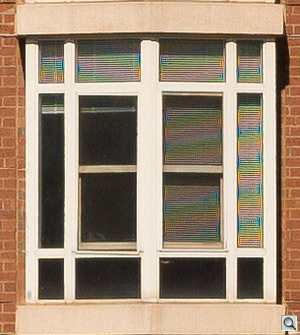 |
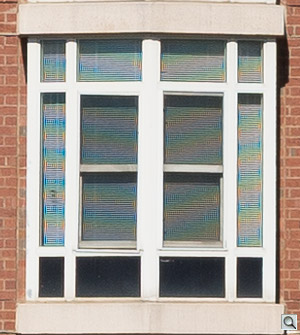 |
Nikon D800E
f/5.6, 1/1000s, ISO 125
24-70mm f/2.8G lens at 50mm |
Nikon D800
f/5.6, 1/800s, ISO 125
24-70mm f/2.8G lens at 50mm |
This first example is a typical building window with blinds shot with the same zoom range and settings on both cameras. Moir� is clearly present in images from both, but is noticeably more pronounced and obvious in the D800E. You can also see that while the settings and conditions are the same, the D800E produces warmer, more saturated colors than the D800. (Note: this is the same window but the blinds were moved during our shooting.)
|
You might say "well, I'll just avoid venetian blinds", but lots of manmade subjects are likely to trigger more subtle color moir� patterns, as seen here:
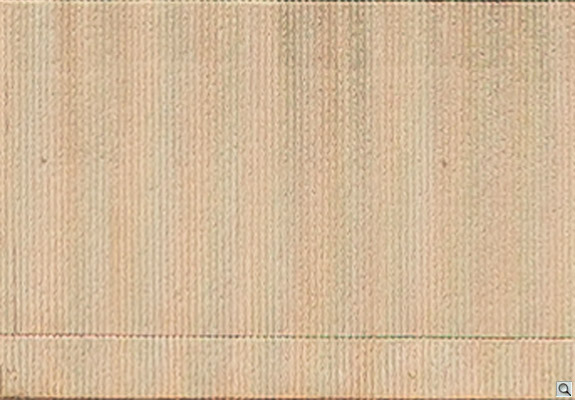 |
Nikon D800E
f/5.6, 1/800s, ISO 125, 24-70mm lens at 28mm |
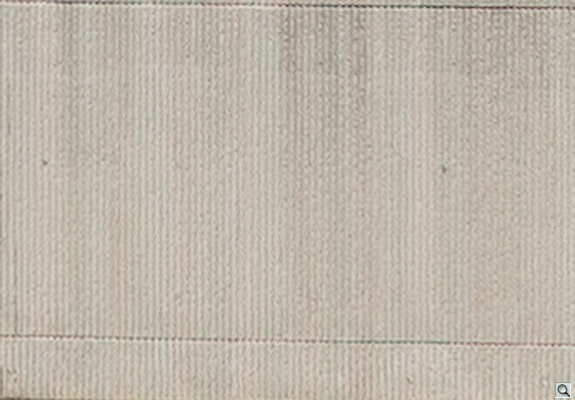 |
Nikon D800
f/5.6, 1/1000s, ISO 125, 24-70mm lens at 28mm |
Shown here is a gray wall alongside the freeway. The rainbow pattern created from the moir� effect is again present in the D800, yet is noticeably more obvious in the D800E. We know the pattern is moir� and not weathering because it's not present at other focal lengths. |
(Needless to say, that's a blank concrete wall; there are no pastel tints in the original. You can see more examples in our Nikon D800e review.)
OK, so we understand that LPFs are good things to have inside our cameras, but they come at a cost. What did Fuji do to get around the issue?
Something like 99+% of all digital cameras on the market use a CFA pattern called a Bayer Array, after it's inventor, the late Bryce Bayer. It arranges the red, green, and blue filters in a 2x2 pattern, RG/GB. (See the little animation at right.) He used twice as many green filters as red or blue, because the luminance signal in our visual system (the part that conveys detail, basically) is mainly associated with the "green channel" in our eyes. The Bayer partern is pretty straightforward, with a very regular pattern in each of the color channels. As a result, if you don't use an LPF, you're very likely to get color artifacts.
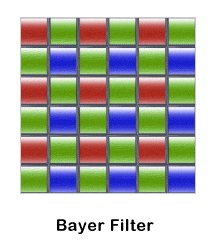 What Fujifilm did with the X-Trans sensor was to go to a much larger 6x6 pixel pattern, with the R, G, and B filters arranged in a pseudo-random pattern within the 6x6 footprint. This amounts to "non-uniform sampling" of the image data, and does some very useful things for you, relative to the Nyquist criterion and aliasing in the captured image. A full explanation is *way* out of my depth, but the basic idea is that you can shift some of the inevitable aliasing to frequencies and amplitudes you won't notice in the captured signal (image). Technically, "An advantage of nonuniform sampling is that some of the benefits of oversampling can be realized without incurring experiment time or resolution penalties." (from: http://www.ncbi.nlm.nih.gov/pubmed/
19414274) You can find more about it in Wikipedia, but you very quickly get into things like Lagrange interpolation and other advanced math. (Interestingly, it turns out that all that advanced math had a lot to do with the X-Trans technology not seeing the light of day until 2012: A Fuji engineer who managed the project told us in an interview that it took five or six years for them to work out all the math and get it into a form that could be handled by a camera's image processor.) What Fujifilm did with the X-Trans sensor was to go to a much larger 6x6 pixel pattern, with the R, G, and B filters arranged in a pseudo-random pattern within the 6x6 footprint. This amounts to "non-uniform sampling" of the image data, and does some very useful things for you, relative to the Nyquist criterion and aliasing in the captured image. A full explanation is *way* out of my depth, but the basic idea is that you can shift some of the inevitable aliasing to frequencies and amplitudes you won't notice in the captured signal (image). Technically, "An advantage of nonuniform sampling is that some of the benefits of oversampling can be realized without incurring experiment time or resolution penalties." (from: http://www.ncbi.nlm.nih.gov/pubmed/
19414274) You can find more about it in Wikipedia, but you very quickly get into things like Lagrange interpolation and other advanced math. (Interestingly, it turns out that all that advanced math had a lot to do with the X-Trans technology not seeing the light of day until 2012: A Fuji engineer who managed the project told us in an interview that it took five or six years for them to work out all the math and get it into a form that could be handled by a camera's image processor.)
Fortunately, it doesn't take a degree in advanced signal processing to appreciate what the X-Trans technology does for your photos: Shots from the X-Pro1, the X-E1, and other cameras using these sensors are unusually sharp and crisp looking, yet with very little tendency to produce moir� patterns or other artifacts. You can see an example of a worst-case subject, in the form of our own resolution target here: http://www.imaging-resource.com/PRODS/fuji-x-pro1/FULLRES/XPRO1hRES4896F.HTM - As you can see, there are some very faint false-color artifacts in some of the areas with very fine detail, but they're really very slight, better than we'd see in some cameras with low-pass filters. (Also, in what I'm sure was a deliberate engineering decision, there don't seem to be any color artifacts with purely horizontal details: The Fuji engineers made sure t
here wouldn't be any venetian-blind problems!)
Phew - I guess I got a little carried away there, you were probably just looking for something like the animated GIF showing the Bayer vs X-Trans CFA patterns. I went to the lengths I did, though, because: a) I wanted to highlight just how clever Fujifilm was in developing the X-Trans technology, and b) wanted to take the opportunity to rant a little to counter the increasingly popular idea that we don't need LPFs on our cameras. Ditching LPFs is a terrible mistake the industry is in the process of making. I hope I didn't lose you along the way, but if you made it through to here, just think of how you'll be able to crush the anti-LPF fanboys at your next cocktail party or photo club meeting! ;-)
-- Dave E.
---------------------------------------------------------------------------------------------------------------
Supporting your sponsors!
Hey guys, just wanted to let you know I just purchased the Sigma 18-250mm lens. I also bought a new D7100 and of course that necessitated a new lens, from Roberts in Indianapolis, the latest 70-200mm f/2.8 VRII. (Hey, I tried B&H, but Roberts offered me $1K against the price of the new one!)
And now Hunt's is offering the newest iteration of Panasonic’s LX series, the LX7, for a limited time, at $349.99. so will replace my wonderful LX5.
Been talking all week with the Sigma men (at the Birding and PhotoFest here in St. Augustine) and now have made arranged again with Roberts to get the 120-300mm f/2.8 with OS/VR (or their equiv.) for only $2,500!
Apparently Roberts bought out their remaining stock of Nikon adapted 120-300mm’s, and since I have done business with them for over 15 years, I get a good price. Yes, there is a new one coming out but the main addition seems gimmicky to me -- although the “weather stripping” would be welcome, but I just avoid inclement weather when I can --and not that big a deal since it will cost $3,600.
So just wanted you to know I am honoring your sponsors, when I can.
Loyal reader,
Nick Baldwin
-----------------------
Hi Nick -
Thanks for that! And thanks even more so for taking time to write this note: You have no idea how much something like this means to an advertiser; I'll be certain to pass it along to Sigma!
I'm glad to hear that you like their lenses so much, too. I've owned Sigma lenses for years myself, and we use Sigma 70mm f/2.8 macros in our lab for testing cameras. They're the sharpest lens we've ever tested for SLRgear, and are available in four different mounts, so we use them as our "gold standard" for testing a wide range of SLR and CSC bodies. We want to be sure we're testing the camera, and not being limited by a sub-standard lens, and the Sigma 70s have been great for that.
Sigma's really been making major strides recently. Since Kazuto Yamaki took over running the company from his father (the founder), they've been doing a lot of innovating, and there seems to be a real focus on pushing the boundaries of quality and capability with their lenses. Their new A1 measuring system is letting them take lens production QC up another notch or two, and their most recent lenses have been fantastic: The 35mm f/1.4 DG "A" tested very well for its aperture and price class, and by all accounts, the new 30mm f/1.4 DC is even better. We just yesterday got our test sample of the new 120-300mm f/2.8 in, and the build quality and handling are positively drool-worthy. It'll be another couple of weeks before we can get it tested and a review posted for it, but it's one of the nicest-feeling lenses I've put my hands on in recent memory.
At any rate, thanks for doing your best to support our advertisers. We couldn't do what we do without them.
Best,
- Dave E.
PS: You might find my interview with Kazuto Yamaki at the last Photokina interesting, he talks a bit about their new lenses and the A1 testing system. http://www.imaging-resource.com/news/2012/09/21/qa-with-sigma-ceo-kazuto-yamaki-geeking-out-over-industry-firsts-lens-tech
---------------------------------------------------------------------------------------------------------------
NEW ON THE SITE
-----------------------
At http://www.imaging-resource.com/new-on-ir you can keep track of what's new on our main site. Among the highlights since the last issue:
- Camera Preview: Samsung NX200 - Affordable mirrorless is now even better connected (http://www.imaging-resource.com/PRODS/samsung-nx2000/samsung-nx2000A.HTM)
- How To: Vincent Laforet video offers helpful tips on time-lapse photography (http://www.imaging-resource.com/news/2013/04/30/vincent-laforet-video-offers-helpful-tips-on-time-lapse-photography)
- How To: Incident vs. reflective - Cinematographer Mark Vargo explains the difference between light meters, and when to use each (http://www.imaging-resource.com/news/2013/04/30/cinematographer-mark-vargo-explains-the-difference-between-light-meters)
- Industry News: Hasselblad V-system takes its final bow (http://www.imaging-resource.com/news/2013/04/29/end-of-an-era-hasselblad-v-system-takes-its-final-bow)
- Video: Photographer captures one-of-a-kind moonrise, thanks to patience and absurdly long focal length (http://www.imaging-resource.com/news/2013/04/29/photographer-captures-one-of-a-kind-moonrise-video)
- Lens Review: Fujinon XF 14mm f/2.8 R (http://slrgear.com/reviews/showproduct.php/product/1539/cat/105)
- Humor: Photographer gets more than he bargained for from frisky parrot (http://www.imaging-resource.com/news/2013/04/26/Photographer-gets-more-than-he-bargained-for-from-frisky-parrot-VIDEO)
- News: Sony announces Photographer of the Year title and other winners in 2013 World Photography Awards (http://www.imaging-resource.com/news/2013/04/25/sony-announces-photographer-of-the-year-title-and-other-winners-in-2013-wor)
- Camera Preview: Sony HX50V - Just how small and lightweight can a 30x optical zoom camera be? (http://www.imaging-resource.com/PRODS/sony-hx50v/sony-hx50vA.HTM)
- Camera Previews: Panasonic launches LF1 enthusiast compact with EVF, upgrades G6 with speed and WiFi (http://www.imaging-resource.com/news/2013/04/23/panasonic-launches-lf1-enthusiast-compact-with-evf-upgrades-g6-with-speed-a)
- Video: The history of photography told in a clever, animated short (http://www.imaging-resource.com/news/2013/04/20/the-history-of-photography-told-in-a-clever-animated-video)
---------------------------------------------------------------------------------------------------------------
NEXT ISSUE
---------------
Our next issue will be mailed to you in two weeks, on Friday, May 20. See you then!
SIGNOFF
-----------
That's it for now, but between issues visit our site for the latest news, reviews, or to have your questions answered in our free discussion forum. Here are the links to our most popular pages:
Newsletter Archive: http://www.imaging-resource.com/cgi-bin/dada-nltr/mail.cgi/archive/irnews
Daily News: http://www.imaging-resource.com/news
SLR Gear: http://www.slrgear.com
New on Site: http://www.imaging-resource.com/new-on-ir
Review Index: http://www.imaging-resource.com/camera-reviews
IR Photo Contest: http://www.dailydigitalphoto.com
Facebook: http://www.facebook.com/imagingresource
Twitter: http://www.twitter.com/IR_Lab
Happy snapping!
Dave Etchells & Roger Slavens
mailto: editor@imaging-resource.com
|







